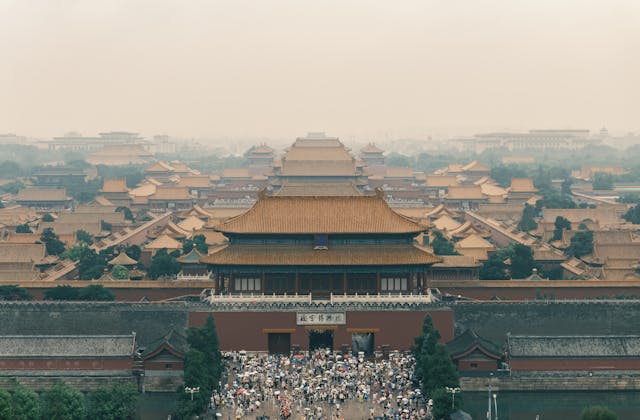
Why is the Forbidden City forbidden? It isn’t today, but for most of its history, access was forbidden to most Chinese people.
The Forbidden City is found pretty much at the heart of the city of Beijing. At least it was. These days, Beijing has sprawled so far that it is difficult to know where one city becomes the next city. Still, the Forbidden City is at the heart of old Beijing. It is a walled complex of buildings that covers 720,000 m2. It has 980 buildings and a total of 8,886 rooms. It gets over 17 million tourist visits a year, making it the most visited landmark in the world, significantly ahead of number two, which is St. Peter’s Basilica in the Vatican City.
So, why is the Forbidden City forbidden? It was built as the residence of the Chinese emperor and his family. The only people that were allowed in besides the imperial family were courtiers and eunuchs. Even the imperial family were not allowed in all of the time or into all of the buildings. The only person who had access everywhere was the emperor. The rules were kept pretty strictly, and anyone not authorized to be there would be immediately executed.
It is called a city, but it is technically a walled palace complex. The Yongle Emperor was responsible for its construction, although he died shortly after construction was finished. He was the third emperor of the Ming Dynasty. When he came to the throne in 1402, there were two claimants to the imperial throne. He was one and he was based in Beijing, which is the capital of the north (the characters are 北 north and 京 capital). The other claimant was the emperor’s nephew, who was the emperor in Nanjing, which was the capital of the south (the characters are 南 south and 京 capital). Nanjing was the original capital of China. The Yongle Emperor rode to Nanjing and defeated his nephew. After he won, he wiped out all opposition in Nanjing and then moved the imperial capital to Beijing. He wanted to make a lasting capital, so he commissioned a walled palace complex in 1406. It took a million workers, but it was built by 1420 and the Yongle Emperor moved in. Unfortunately, he died 4 years later in 1424, but he had made the lasting capital he had dreamed of and his walled palace complex would survive the next half millennium.
The complex is enormous, and the buildings inside it are very imposing. The whole complex was built on a north-south line, in compliance with the rules of feng sui. The complex was used to receive guest from within China and from other countries. All of the buildings and the spaces between them in the complex were designed to showcase the power of the emperor and the insignificance of the person visiting them. It was designed to inspire awe. Even the gate into the city was enormous.
The Forbidden City was the home of the Emperor of China for the next 604 years. 24 emperors from two different dynasties called the Forbidden City home. There were only two occasions during all of that time when an emperor wasn’t in control of the city. The first time was during the Second Opium War against the UK and France in 1860. British and French forces took control of the city until the end of the war when they returned it after the emperor was forced to sign a humiliating peace treaty. The second time was during the Boxer Rebellion in 1900 because the imperial family had to flee from Beijing. They reoccupied it a year later.
The last emperor to live in the Forbidden City was Puyi, who was the last emperor of China. He was basically overthrown in 1912, during the revolution, and he was forced to abdicate. He was allowed to continue living in the inner buildings of the Forbidden City until 1924, but it was no longer “forbidden” and he was no longer emperor. The Forbidden City was turned into a museum after Puyi left. Some of the relics from within the city were moved to Taiwan when the Japanese invaded China, and they were kept in Taiwan after the fleeing Chinese government moved there in 1949. Today, the Forbidden City is a World Heritage Site and you can enter it without having to worry about summary execution. And this is what I learned today.
Photo by zheng liang: https://www.pexels.com/photo/forbidden-city-in-beijing-17642910/
Sources
https://www.britannica.com/topic/Forbidden-City
https://en.wikipedia.org/wiki/Forbidden_City
https://en.wikipedia.org/wiki/Yongle_Emperor
https://www.travelchinaguide.com/why-is-it-called-forbidden-city.htm
https://www.travelchinaguide.com/cityguides/beijing/forbidden.htm
https://www.birmingham.ac.uk/research/perspective/the-forbidden-city
https://en.wikipedia.org/wiki/Beijing
https://en.wikipedia.org/wiki/List_of_most_visited_palaces_and_monuments

Pingback: #923 Why did the Chinese government move to Taiwan?